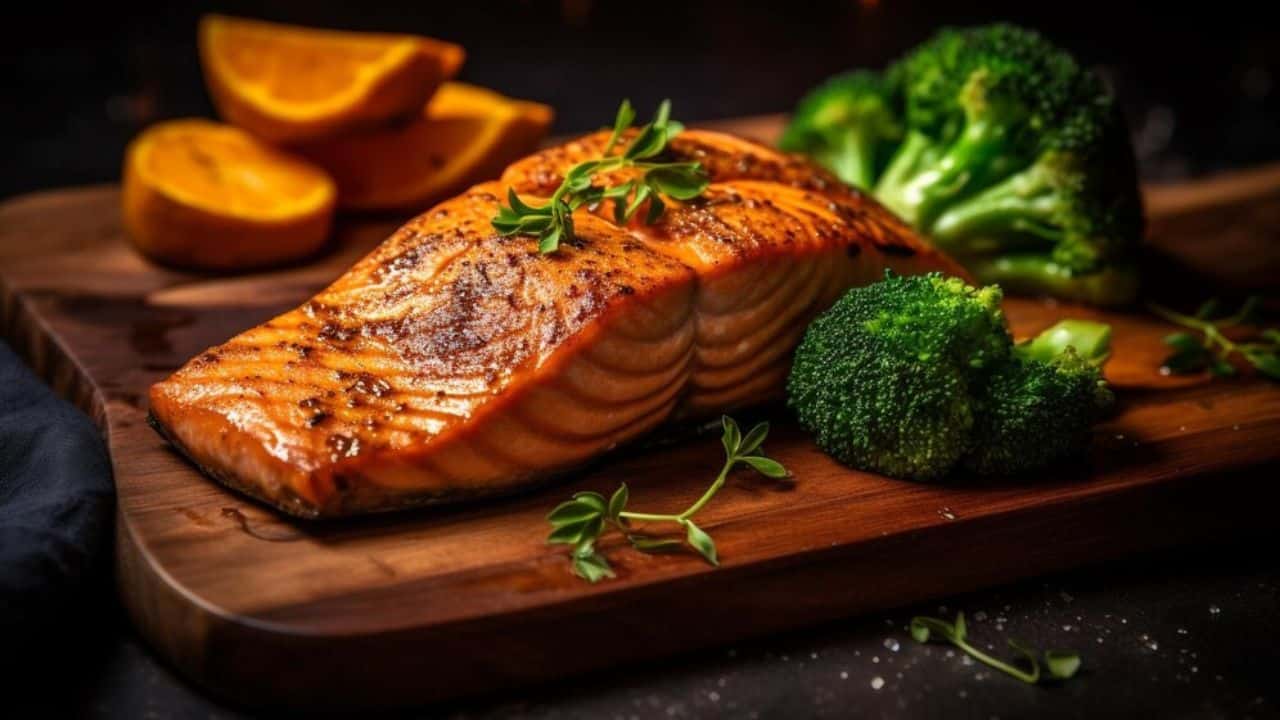Salmon is a delightfully rich fish with a lot of natural flavor. While you have the option to cook it at a lower temperature, 400°F is ideal as it imparts some color to the salmon and results in crispy skin. Here is some guidance on the recommended baking duration for salmon at 400°F.
Table of contents
How Long To Bake Salmon At 400 F?
Baking salmon at 400°F (200°C) is a common method for cooking it, and the cooking time can vary depending on the thickness of the salmon fillet or steak. As a general guideline, you can bake salmon at 400°F for approximately 15-20 minutes per inch of thickness.
SEE ALSO: Can Fish See Water? Everything to Know
How Long To Bake Salmon At 400 F Without Foil
Cooking salmon at 400 degrees Fahrenheit without a cover or aluminum foil typically requires about 10 to 12 minutes, sometimes even less. Baking salmon uncovered results in a shorter cooking time compared to using foil, but it’s important to be cautious as this method increases the potential for the salmon to become dry.
To maintain the salmon’s moisture, you can apply 2 or 3 tablespoons of melted butter to the salmon before placing it in the oven. You can also consider pouring some of the melted butter into the bottom of the baking dish.
READ ALSO: Can You Microwave Parchment Paper?
How To Cook Salmon In The Oven At 400 F
Here are the steps to take if you want to cook salmon in the oven at 400 f:
Step 1
Begin by preheating the oven to 400 degrees Fahrenheit. Cover a baking sheet with either aluminum foil or parchment paper and apply a non-stick cooking spray to it. Position the salmon on the prepared baking sheet with the skin side facing downward.
Step 2
Combine olive oil, lemon juice, salt, and pepper. Brush this mixture onto the salmon fillets, and feel free to sprinkle a bit more salt and pepper for added seasoning.
Step 3
Bake the salmon for approximately 12-15 minutes or until its internal temperature reaches 135 degrees Fahrenheit. Take it out of the oven and allow the salmon to rest until the temperature rises to 145 degrees Fahrenheit.
READ ALSO: How Long Do Chickens Live: Understanding the Lifespan of Backyard Poultry
How to Properly Bake Salmon at 450
Baking salmon at 450°F is not advisable since it could result in an overly crispy exterior and a raw center. To achieve a moist and flaky texture, it’s better to use a lower temperature.
For a simple preparation, you only need a fresh or thawed salmon fillet that fits on your sheet pan, and a piece of non-stick foil or parchment paper to line the bottom. If your salmon is frozen, consider cooking it using a different method. Optionally, use a meat thermometer to check for doneness, and adjust the oven to broil if a more even browning is desired.
How Long To Bake 1 Lb Salmon At 400 F
For a 1 lb portion of salmon, the recommended baking time at 400°F is between 15 to 20 minutes. It’s advisable to start checking the salmon’s internal temperature about 5 minutes before the suggested cooking duration is up, for instance, commence checking around the 10 or 15-minute mark, and continue to monitor it every 2 minutes until it reaches a range between 145°F and 160°F.
The baking time for salmon fillets can vary based on several factors such as fillet size, oven temperature, and the quantity of salmon being prepared. If you’re dealing with a substantial number of salmon fillets for air frying, it’s best to cook them in separate batches to prevent overcrowding in the basket. This approach ensures even cooking and allows for proper air circulation.
How Long To Bake Salmon At 400 F In The Air Fryer
You can also prepare salmon at 400°F using your air fryer. When air frying salmon, you have the option to either enclose it in aluminum foil or cook it without a cover. Salmon cooked without a cover in your air fryer at 400°F typically requires about 8 to 12 minutes for the baking process.
Alternatively, you can choose to wrap your salmon in aluminum foil when using your air fryer, which helps to retain its moisture. Baking salmon covered in aluminum foil in your air fryer at 400°F will usually take around 6 to 10 minutes.
When air frying salmon at 400°F, it’s important to closely monitor the cooking process to prevent it from burning or overcooking. Because the air fryer is a smaller oven, it cooks faster, necessitating vigilant attention to avoid overcooking or burning your salmon.
It’s always a good idea to set your cooking time for less than you think you will need, check on it, and air fry your baked salmon longer if needed.
How Long To Grill Salmon At 400 F
When grilling salmon at 400°F, it will generally require about 10 to 20 minutes to reach full doneness. It’s advisable to closely monitor your salmon while grilling to avoid overcooking, as certain spots on your grill might have higher temperatures than others.
FAQs On How Long To Bake Salmon At 400
Yes, you can bake salmon covered with aluminum foil at 400°F. It will generally take a little less time than baking it uncovered. This method helps retain moisture.
Yes, it’s a good practice to preheat your oven to 400°F before placing the salmon inside. This ensures even cooking.
Yes, you can bake salmon in an air fryer at 400°F. Cooking times in an air fryer may be shorter than in a traditional oven, so monitor it closely to prevent overcooking.
To keep salmon moist, you can brush it with oil, butter, or a marinade before baking. Adding a bit of liquid or wrapping it in aluminum foil can also help trap moisture.
Wild salmon is always a great choice because of its nutrients and flavor. Some of the best varieties are sockeye salmon, coho, and king salmon.
Conclusion
Baking salmon at 400°F is the ideal temperature for retaining its moisture and enhancing its rich flavor. Once you’ve set this temperature, you have the flexibility to season it in numerous ways.
References
- halfscratched.com – HOW LONG TO BAKE SALMON AT 400 F
- foodlovingfamily.com – How Long To Cook Salmon At 400






